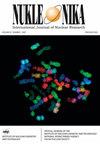癌症与室内氡暴露关系的肿瘤流行病学联合分析
IF 0.3
4区 物理与天体物理
Q4 CHEMISTRY, INORGANIC & NUCLEAR
引用次数: 5
摘要
摘要目的:根据近年来世界不同地区肺癌和室内氡流行病学及医学统计研究结果,对居住暴露对健康的影响进行了新的综合分析。特别是,新数据是通过病例对照研究的荟萃分析获得的,并在地理汇总数据的研究中考虑了人乳头瘤病毒感染的混淆效应。材料和方法:考虑了两种流行病学数据来源:(1)生态设计研究和(2)病例对照研究。生态学研究包括对美国各县和俄罗斯各州进行的分析,并对主要混杂因素进行了调整。病例对照研究的数据来自对31项单独研究的荟萃分析,并根据氡暴露重建的质量和参照组的规模对获得的优势比进行加权。合并了与室内氡暴露有关的肺癌过度相对危险度(ERR)的估计。结果:两种类型的流行病学研究设计提供了大致一致的EER估计。氡暴露ERR的综合值为每100 Bq/m3 0.14 (90% CI: 0.10-0.18)。结论:俄罗斯和美国地区现有的地理汇总数据以及在许多国家进行的病例对照研究的荟萃分析证实,肺癌与室内氡暴露有关。本文章由计算机程序翻译,如有差异,请以英文原文为准。
Combined analysis of onco-epidemiological studies of the relationship between lung cancer and indoor radon exposure
Abstract Objectives: Recent results of epidemiological and medical statistics studies of lung cancer and indoor radon in different regions of the world make a relevant new combined analysis of residential exposure health effects. In particular, new data were obtained by means of a meta-analysis of case-control studies as well as taking into account a confounding effect of human papillomavirus infection in studies of geographically aggregated data. Materials and methods: Two sources of epidemiological data are considered: (1) studies of ecological design and (2) case-control studies. Ecological studies included the analysis performed for the USA counties and Russian oblasts with adjusting for the main confounders. Data on the case-control studies were gained from the meta-analysis of 31 individual studies with a weighting of obtained odds ratios according to the quality of radon exposure reconstruction and size of the reference group. Estimations of lung cancer excess relative risk (ERR) associated with indoor radon exposure are combined. Results: Two types of epidemiological study design provided generally consistent EER estimations. The combined value of ERR due to radon exposure is 0.14 (90% CI: 0.10–0.18) per 100 Bq/m3. Conclusion: Available geographically aggregated data in regions of Russia and the United States and the meta-analysis of case-control studies conducted in a large number of countries confirm the association of lung cancer with indoor radon exposure.
求助全文
通过发布文献求助,成功后即可免费获取论文全文。
去求助
来源期刊

Nukleonika
物理-无机化学与核化学
CiteScore
2.00
自引率
0.00%
发文量
5
审稿时长
4-8 weeks
期刊介绍:
"Nukleonika" is an international peer-reviewed, scientific journal publishing original top quality papers on fundamental, experimental, applied and theoretical aspects of nuclear sciences.
The fields of research include:
radiochemistry, radiation measurements, application of radionuclides in various branches of science and technology, chemistry of f-block elements, radiation chemistry, radiation physics, activation analysis, nuclear medicine, radiobiology, radiation safety, nuclear industrial electronics, environmental protection, radioactive wastes, nuclear technologies in material and process engineering, radioisotope diagnostic methods of engineering objects, nuclear physics, nuclear reactors and nuclear power, reactor physics, nuclear safety, fuel cycle, reactor calculations, nuclear chemical engineering, nuclear fusion, plasma physics etc.
 求助内容:
求助内容: 应助结果提醒方式:
应助结果提醒方式:


